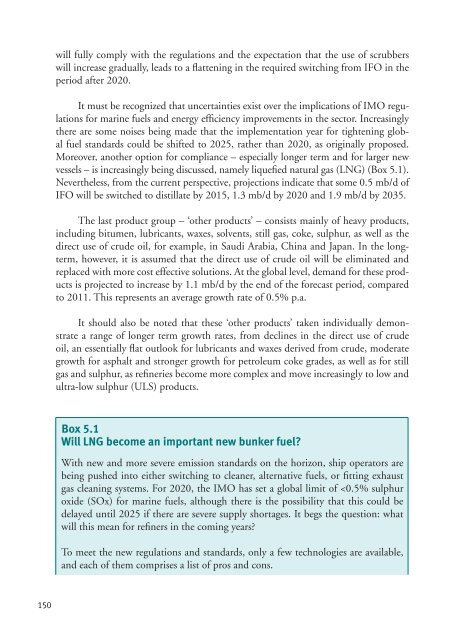World Oil Outlook - Opec
World Oil Outlook - Opec
World Oil Outlook - Opec
- TAGS
- world
- outlook
- opec
- www.opec.org
You also want an ePaper? Increase the reach of your titles
YUMPU automatically turns print PDFs into web optimized ePapers that Google loves.
150<br />
will fully comply with the regulations and the expectation that the use of scrubbers<br />
will increase gradually, leads to a flattening in the required switching from IFO in the<br />
period after 2020.<br />
It must be recognized that uncertainties exist over the implications of IMO regulations<br />
for marine fuels and energy efficiency improvements in the sector. Increasingly<br />
there are some noises being made that the implementation year for tightening global<br />
fuel standards could be shifted to 2025, rather than 2020, as originally proposed.<br />
Moreover, another option for compliance – especially longer term and for larger new<br />
vessels – is increasingly being discussed, namely liquefied natural gas (LNG) (Box 5.1).<br />
Nevertheless, from the current perspective, projections indicate that some 0.5 mb/d of<br />
IFO will be switched to distillate by 2015, 1.3 mb/d by 2020 and 1.9 mb/d by 2035.<br />
The last product group – ‘other products’ – consists mainly of heavy products,<br />
including bitumen, lubricants, waxes, solvents, still gas, coke, sulphur, as well as the<br />
direct use of crude oil, for example, in Saudi Arabia, China and Japan. In the longterm,<br />
however, it is assumed that the direct use of crude oil will be eliminated and<br />
replaced with more cost effective solutions. At the global level, demand for these products<br />
is projected to increase by 1.1 mb/d by the end of the forecast period, compared<br />
to 2011. This represents an average growth rate of 0.5% p.a.<br />
It should also be noted that these ‘other products’ taken individually demonstrate<br />
a range of longer term growth rates, from declines in the direct use of crude<br />
oil, an essentially flat outlook for lubricants and waxes derived from crude, moderate<br />
growth for asphalt and stronger growth for petroleum coke grades, as well as for still<br />
gas and sulphur, as refineries become more complex and move increasingly to low and<br />
ultra-low sulphur (ULS) products.<br />
Box 5.1<br />
Will LNG become an important new bunker fuel?<br />
With new and more severe emission standards on the horizon, ship operators are<br />
being pushed into either switching to cleaner, alternative fuels, or fitting exhaust<br />
gas cleaning systems. For 2020, the IMO has set a global limit of
















